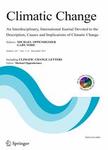版权所有:内蒙古大学图书馆 技术提供:维普资讯• 智图
内蒙古自治区呼和浩特市赛罕区大学西街235号 邮编: 010021

作者机构:Cent China Normal Univ Key Lab Geog Proc Anal & Simulat Wuhan 430079 Hubei Peoples R China Cent China Normal Univ Coll Urban & Environm Sci Wuhan 430079 Peoples R China CMA Inst Dev & Programme Design CMA Key Open Lab Transforming Climate Resources Ec Beijing 100081 Peoples R China
出 版 物:《CLIMATIC CHANGE》 (Clim. Change)
年 卷 期:2025年第178卷第2期
页 面:1-24页
核心收录:
学科分类:0830[工学-环境科学与工程(可授工学、理学、农学学位)] 07[理学] 070601[理学-气象学] 0706[理学-大气科学]
基 金:National Natural Science Foundation of China [42077441, 42001096] National Natural Science Foundation of China
主 题:Compound extreme events CMIP6 Performance evaluation Future projection China
摘 要:In the context of global warming, the frequency and intensity of extreme temperature and precipitation events are increasing. Under this scenario, an increase in compound extreme events would pose a greater risk to human society and ecosystem. However, the modelling and future projection of various types of compound events remain a great challenge. Therefore, in this study, we first evaluate the simulation performance of CMIP6 climate models for six types of compound extreme event in China in terms of spatial distribution, interannual variability and interdependence during the historical period. Based on this performance evaluation, we select the 6 best models, which are then utilized to project future changes of compound events under the SSP1-2.6, SSP2-4.5, and SSP5-8.5 scenarios for the next three time periods (2015-2043, 2044-2071, and 2072-2100). The results are as follows: (1) The performance of GCMs in the simulation of extreme temperature indices is better than that for extreme precipitation indices, and positive biases exist in extreme precipitation indices for most models. (2) In the historical period, the consistency between the simulation and observation of compound extreme events show large heterogeneity for different models and different events. (3) The frequency percentage and spatial extent of compound extreme events associated with warm extremes will increase in the future, while compound extreme events associated with cold extremes, except for SP&Tn10, will show a decreasing trend. (4) Spatially, the Pr90&Tx90, Hot&Dry and Cold&Dry in the southern region will increase significantly. In the Tibetan Plateau, except for Pr90&Tn10, all other compound extreme events will have a large increase. In Northeast and North China, SP&Tx90 and Pr90&Tx90 are projected to increase. The results from this study underline how the evaluation and the future projection of compound extreme events have the potential to improve the understanding of climate model uncertainty